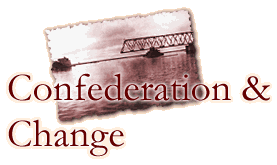
 A fishermen's co-operative in Cow Head
A fishermen's co-operative in Cow Head
 A newly-built road along the coast made communities less isolated
A newly-built road along the coast made communities less isolated
 Communities like Sally's Cove depended on the lobster fishery
Communities like Sally's Cove depended on the lobster fishery
 The town of Lomond, before becoming a victim of resettlement
The town of Lomond, before becoming a victim of resettlement

During the second World War, the United States had built four large air and naval bases on the island, and Canada was fearful of Newfoundland joining the US. After a lot of fuss and debate, Newfoundland joined Canada in 1949. The oldest British colony became Canada's youngest province.
During the push for Confederation, Newfoundlanders were split as to what Confederation would mean, and what changes it would bring. Some people were eager to join Canada and start receiving the "baby bonus", still others worried about how it would upset their way of life. In the end, Confederation brought with it both advantages and disadvantages. Most welcomed the social programs such as unemployment insurance and old-age pensions. The increased government regulation, and decrease in self-sufficiency were not so welcome. One problem was the encouragement of corporate ownership instead of family ownership, which left the riches in the hands of the few. Fortunately, merchant shops declined as more fisherman's co-ops took their place. The cash system was slowly replacing the generations-old barter system. Many fishermen took out loans to buy new supplies and gear, and were then at the mercy of the stock markets. When stocks took a downward slide, so did the lives of many of the fishermen's families.
The fishery had other problems as well. Increased use of offshore draggers had depleted the inshore fish stocks, making fishing a less dependable livelihood than it had been before. Emigration to other provinces and the United States had always been happening in the coastal villages, but now even more so. The uncertainty of the fishery and idealized visions of other places on television and magazines made many young Newfoundlanders leave the island.
People became less isolated after road building had begun up the Northern Peninsula during the 1950's. In 1967, a road was built around the north shore of Bonne Bay, avoiding the ferry service between Woody Point and Norris Point. This had a negative impact on the economy on the south side of the bay. Trout River took the longest time to be connected by a road. A rough track was completed in the 1950's, and it wasn't until 1975 before there was a paved road.
In the 1960's the demand for dried cod died out, due to advances in refrigeration. Fresh fish and lobster were in high demand, and were shipped fresh to market via refrigerated trucks. Fishing familes had more free time, now that less time was spent on the preparation of dried cod. At the same time, less time was spent on home vegetable gardens and the like, as the new cash economy and improved roads meant supplies and groceries were always available in local stores. Families were becoming less self-reliant.
A major impact on life after Confederation was the resettlement program. The provincial government wanted to centralize services in bigger communities to save money. As a result, some 30,000 people across the province were moved out of their homes, and into larger communities. Lomond, Gadds Harbour, Chimney Cove and Cow Head (Summerside) were all resettled. When people moved from their own communities into larger ones, less land prevented them from tending their own gardens and raising livestock. The traditional way of life was slowly eroding away.
| << previous | next >> |